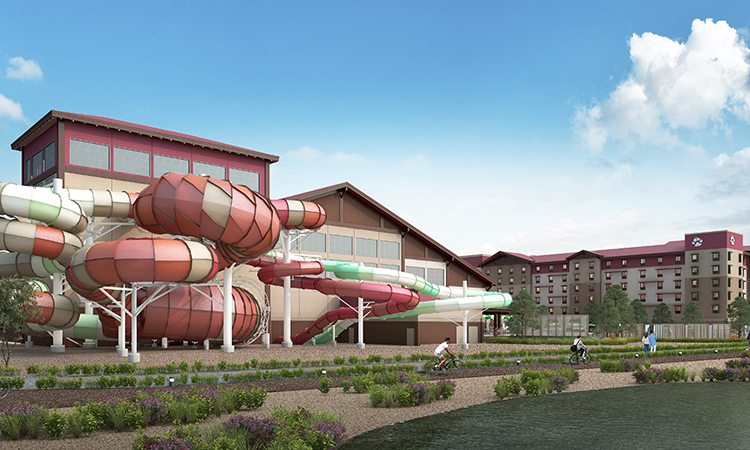Arizona is frequently known as a popular state to visit because of its great weather and outdoor adventures. What people might not know is that a major contributor to the strong economy in Arizona that comes from the tourism industry is due to entertainment corridors all over the state.
Entertainment corridors are walkable areas that often include hotels, restaurants, retail and other activities. According to Brett Hopper, vice president of real estate development of The Opus Group, an entertainment district needs to have three qualities in order to achieve success. To start, the area must be destination-oriented and pedestrian-focused.
“As opposed to an isolated retail location where you go for one particular purpose and you leave,” Hopper said. “Entertainment corridors are go and stay locations and then people can walk around within this district to enjoy all of the activities that are there.”
Then the developer must make sure that the area is full of activities that continue to delight with every visit. He said, “It can’t just be something that’s going to be here today and gone tomorrow.”
Lastly, Hopper explained that an entertainment corridor needs to have some sort of thematic element such as landscaping or signage that gives the area a unique identity.
All of these elements come together to form the entertainment corridors that contribute to Arizona’s thriving tourism industry. President and CEO of the Arizona Lodging and Tourism Association Kim Sabow said, “Tourism is truly the life blood of our state.”
Sabow came to this conclusion after understanding the research done by the Arizona Office of Tourism. That research highlighted the true impact that tourism has on the state of Arizona.
Tourism boosts Arizona’s economy, seeing as direct visitor spending brought in $22.7 billion in 2017, Sabow said. And tourism is the only industry that has a positive economic impact in all 15 Arizona counties. Entertainment corridors make Arizona a great place to visit because everything is in close proximity, so people can easily experience multiple activities a day.
Cactus League Director of Operations Bridget Binsbacher said, “The Cactus League has become an industry all its own, and part of the success is because of the attraction to Arizona.” Last year alone, Spring Training brought 1.1 million out of state attendees, she said.
The Cactus League began in 1947 with only one team and has grown to 10 facilities throughout the state that are home to 15 MLB teams. The walkability of the entertainment corridors that encompass these facilities allows Spring Training fans to have a better experience.
“The big difference between the Cactus League and the Grapefruit League was all of our organizations, our facilities, and our cities are talking to each other,” Binsbacher said. “And the proximity of our facilities… you can get to multiple games in one day. It’s more affordable and it’s more manageable not just for the teams and the players, but for all of the visitors that come to our city.”
The Cactus League provides a large boost to the state’s economy every year. Just last year, Spring Training brought in $644 million in revenue, and it is only continuing to grow, Binsbacher said.
As a developer, Hopper considers the impact of entertainment corridors, “It’s incalculable, the economic impact and the indirect benefits that come from those types of sports complexes, those activities, entertainment districts and corridors that we have in the Valley because that gives confidence to the development community to move forward with projects.”
Arizona has seen growth in many industries since entertainment corridors started driving traffic to the state. Hopper looks back on when Tempe Town Lake didn’t even exist 15 years ago, and even though many people thought it was a crazy idea, it created an energy that continues to build on itself and surges through the city keeping it lively.
“You’ve had ASU which is clearly a big driver that’s always going to be there,” Hopper said. “You have the entertainment corridor of Mill Avenue. You’ve got the business corridor along Tempe Town Lake and you have the myriad of activities that come to Tempe every week from across the country.”
This is the energy that drives the tourism in Arizona and ultimately boosts the economy. Hopper believes that there are many opportunities for growth in Arizona with entertainment corridors. “It comes about because of the courage that it has taken to do these kinds of things, such as sports complexes and entertainment districts,” he said.
The development and growth of these entertainment corridors are increasing revenue and making Arizona an increasingly popular destination for entertainment. Aaron Studebaker, community development project manager at Salt River Pima-Maricopa Indian Community said, “The introduction of Salt River Fields brought that heart beat and the 500,000 people that come to that facility throughout the year.”
The Salt River community is growing fast and becoming a great center for the Pima-Maricopa Indian community. Studebaker has reflected on watching as Talking Stick Entertainment District went from a run-down shopping area to the thriving hub it is today.
“Starting in 2010, we’ve seen incredible development growth, and we’ve seen entertainment properties like Octane Raceway, TopGolf and OdySea in the Desert,” he said. “We’ve seen expansion of office users and educational properties.” The community is also seeing areas such as The Pavilions turn to where they are only doing new builds now.
There is nothing but excitement radiating from the Salt River community as they continue to grow. Studebaker still attributes this economic growth in the area and the number of visitors to the “heartbeat” that Salt River Fields at Talking Stick has brought to the community.
Studebaker is even more excited for what’s coming next. The Salt River community will be welcoming the Great Wolf Lodge, an indoor water park and hotel; White Castle, a restaurant chain originating in the Midwest; and Medieval Times, a dinner and show inspired by the past. These are just a few of the exciting developments Studebaker was able to share, but he did say that there is more in development that will be announced later on.
There is so much potential for Arizona with the expansion of these entertainment corridors. As Binsbacher said, “These facilities that we’ve talked about and all of the developments are critical not just during Spring Training but year-round.”




